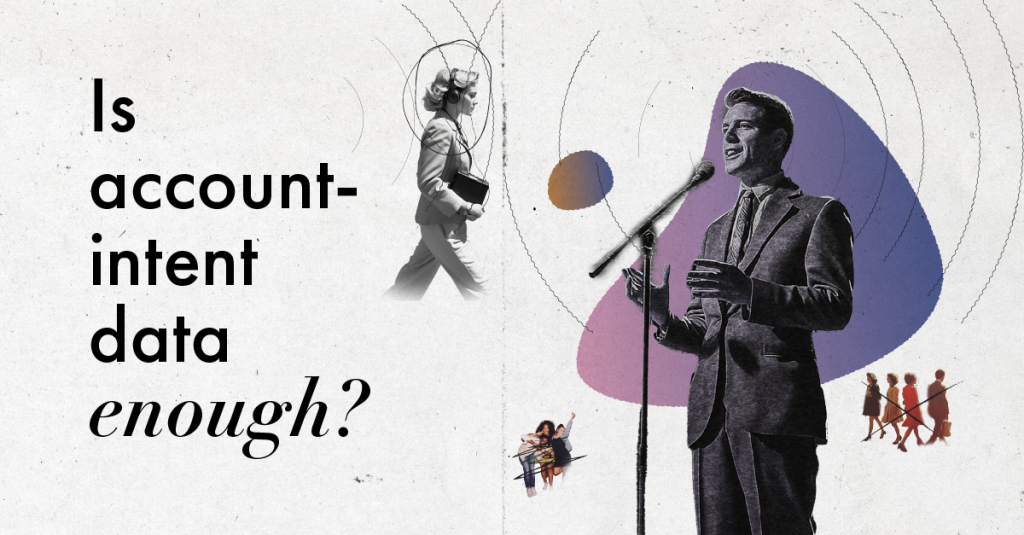
Is account-intent data enough? The case for contact-level intent.
Published on 21 March, 2025 | Author: Thomas Koletas
In today’s competitive business landscape, intent data has become the cornerstone of targeted marketing and sales strategies. It provides valuable insights into who might be in the market for your products or services, and so far, it’s most commonly evaluated on an account-level.
But while many organizations rely heavily on account-level, can it truly unlock your full potential? While account-level intent data provides a strong foundation, it’s becoming clear that account-level is not enough on its own.
The limitations of account-intent data
Account-level intent data focuses on identifying signals from organizations or companies as a whole. It’s useful for giving a broad overview of which businesses might be in the market for your solutions. However, it comes with limitations:
1. Broad signals, vague opportunities
Account-level data often lacks granularity. While it can tell you that someone at a specific company is showing interest in a specific topic, it doesn’t provide insights into who within the company is engaging.
Imagine that you see a large corporation is browsing topics related to cloud computing. Is it the CTO browsing the news, a junior IT analyst just researching the topic, or someone in procurement looking for a cloud computing solution? Without clarity, targeting becomes a guessing game.
2. Misaligned messaging
Without knowing the individual’s role or intent, your outreach might miss the mark. Sending technical specifications to a procurement officer or pricing details to an engineer is unlikely to resonate, wasting time and energy on both sides.
3. Wasted resources
Account-level intent often results in wasted efforts as sales teams chase leads that ultimately don’t convert. According to Forrester, up to 99% of leads generated by marketing never convert to customers, often due to a lack of precise targeting.
So if account-level isn’t enough, then what is? Enter in contact-level intent data: it adds the specificity needed to turn interest into action, delivering better ROI and a superior customer experience. By combining both types of data, businesses can target the right accounts and the right individuals within them, ensuring their strategies are both efficient and effective.
The value of contact-level intent data
Contact-level intent data takes the granular approach, diving into the behaviors of specific individuals within an account. This data reveals not just which company is interested, but who is actively researching, engaging, or making decisions. Here’s why it matters:
1. Precision targeting
With contact-level data, you can identify key decision-makers and influencers. This ensures your message lands in front of the right person at the right time.
According to Gartner, 77% of B2B buyers feel their latest purchase was complex or difficult. Personalized, targeted outreach can simplify this process.
2. Personalized engagement
Knowing the individual’s role, preferences, and specific pain points allows for hyper-relevant messaging. Personalized communication increases the likelihood of building trust and closing deals.
For example, if a marketing manager is searching for lead generation tools, offering content on boosting campaign ROI will resonate more than generic marketing materials.
3. Improved sales efficiency
Contact-level intent data helps sales teams prioritize their efforts, focusing on high-potential leads rather than casting a wide net.
In fact, companies that personalize their outreach based on detailed intent data experience a 20% increase in sales productivity.
4. Enhanced customer experience
Understanding individual intent allows for meaningful interactions that address specific needs, fostering a positive and lasting impression of your brand.
How contact-level intent complements account-intent data
The debate isn’t necessarily about choosing one over the other; it’s about leveraging both effectively. Here’s how contact-level intent data enhances the value of account-level insights:
1. Identifying active stakeholders
While account-level data identifies interested organizations, contact-level data pinpoints who within the company is driving the interest. This makes it easier to navigate complex B2B buying processes involving multiple stakeholders.
2. Enabling smarter outreach
Combining account and contact-level insights allows for tiered engagement strategies. For instance, you can tailor executive-level pitches while providing technical details to practitioners.
3. Reducing noise
By focusing on specific individuals showing intent, you can eliminate irrelevant contacts within an account and avoid overwhelming your sales team with low-quality leads.
Real-life applications of contact-level intent data
1. SaaS companies
A SaaS company offering project management software could use contact-level intent data to identify specific roles—such as project managers or operations leads—actively researching tools. This allows them to tailor demos and follow-ups effectively.
2. Enterprise solutions
For companies selling high-value solutions, identifying decision-makers (e.g., CIOs or heads of procurement) is crucial. Contact-level intent data ensures that sales reps aren’t wasting time pitching to individuals without purchasing power.
3. Account-based marketing (ABM)
ABM strategies thrive on precision. Contact-level data ensures that marketing teams can craft highly relevant campaigns targeting both decision-makers and influencers within a target account.
How to leverage contact-level intent data
1. Invest in the right tools
To effectively leverage contact-level intent data, investing in the right tools is crucial—Programmatic Nurture™ by Digitalzone is exactly the tool you need. With its multi-channel demand generation capabilities, Programmatic Nurture™ harnesses the power of intent data to target the right individuals, at the right time, with the right message.
2. Align marketing and sales
Intent data is only valuable when used effectively. Ensure marketing and sales teams collaborate to create tailored outreach strategies based on shared data.
3. Use multi-channel strategies
Craft your marketing strategy to span across multiple digital touchpoints—email, display ads, website, etc.—to increase engagement chances.
4. Continuously analyze and optimize
Track the performance of campaigns driven by contact-level intent data and refine your approach based on what works best.
The future of intent data
The evolution of marketing standards is leaning heavily towards personalization. As businesses increasingly prioritize customer experience, contact-level intent will become the gold standard for driving meaningful interactions. Advances in AI and machine learning will further enhance the ability to predict individual intent, making outreach even more precise.
Why contact-level intent matters
In the end, success in marketing and sales isn’t just about knowing where to look; it’s about knowing who to engage. Contact-level intent is the key to bridging that gap and staying ahead in today’s competitive landscape.
